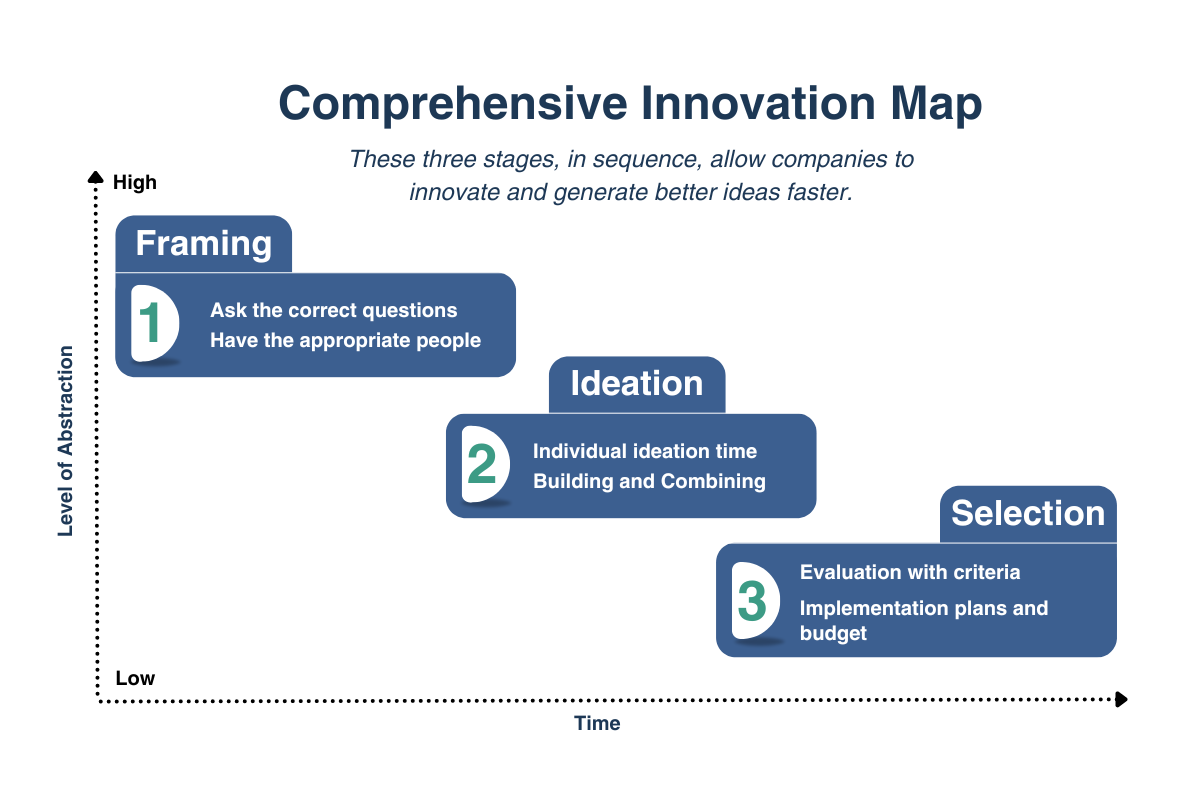Our clients often ask us how they can become more innovative. Some seem to believe that innovation just appears as if by magic. Many believe that there is no innovation process, even though there have been significant breakthroughs in this field of study. Some companies benefit from recent best practices that help improve innovation efforts, but many don’t know about them because they are still hidden within academia. The three practices we have identified consist of a research-verified, end-to-end series of steps that yield the best ideas. You can apply this three-step method to small problems in as little as a day or scale it to solve the largest challenges spanning several months or more.
Benefits:
- Maximizes the quality of new ideas from brainstorming
- Helps address simple as well as complex problems
- Is resource efficient because it is focused, managed, and time bound
- Easy to deploy and you get results quickly
This successful innovation program consists of three steps:
- Framing
- Ideation
- Selection
The first step is to frame the problem. It is said that if Einstein had 20 days to solve a problem, he would spend 19 days defining the problem and leave one day to solve it. A book by McKinsey researchers called Brainsteering: A Better Approach to Breakthrough Ideas by Coyne and Coyne suggests there are five areas that generate the best questions to help spur innovation:
- Identifying unsolved customer problems
- “De-averaging” users and activities
- Exploring unexpected successes
- Imagining perfection
- Discovering unrecognized “headroom” (rules to reexamine or new technologies)
Once you define the questions, it is very important to select the best people to address them, largely ignoring the management hierarchy. You can address the organizational politics in the third step.
The second step is ideation. Here again, research by Terwiesch and Ulrich (cf. Innovation Tournaments: Creating and Selecting Exceptional Opportunities) finds that brainstorming, the tried and true group method, is flawed. Allowing time for individual contemplation before engaging in a group process can generate significantly better ideas than brainstorming alone.
In past brainstorming sessions, you probably found that some people dominated the discussion, preventing others from contributing their thoughts. You have probably experienced “groupthink” at some point, where one idea that seems to resonate with a vocal minority gets repeatedly reinforced, limiting the expansion of the concept.
By having an initial individual-thinking session (as brief as ten minutes), you can have a significantly improved process because the ideas going into the group session will be stronger and more diverse. Use a group process to improve, modify, or combine ideas in order to get a better concept.
The third step is selection, where you choose from among the proposed product ideas and make plans for implementation. There are many alternative methods for product concept selection. Selection methods are available from ideation software vendors such as Brightidea and Spigit. There is also a software tool associated with Innovation Tournaments that you can use called the Darwinator, which is a web-based application that builds on the concepts developed by Terwiesch and Ulrich.
After completing these three steps, you must fund or plan to implement the selected idea. These group sessions will die out or lack creative energy if the participants notice that you do not act upon winning ideas.
There are two ways to go about funding these concepts. The first and most likely step is to insert the idea into the product development process so that the idea is “fast tracked.” This assumes that the idea has relatively low technical risk. The second way is to create a skunkworks project where you allow an isolated team to develop the concept by themselves. However, this postpones the integration of the idea into corporate processes, which must happen at some point. You can also hide or rename the idea to prevent corporate antibodies from attacking it. UNIX was developed this way. It was described to management as a word-processing program for patent applications.
Which Business Problems Do These Tools Solve?
These three tools, in sequence, allow companies to innovate and generate better ideas faster. Because these methods emphasize both individual thinking and group brainstorming, it also significantly improves team morale.
What Else You Should Know
Rarely does a technique like this create brand-new, breakthrough business areas. Other mechanisms, such as bottom-up, customer-driven, and focused innovations by dedicated researchers, produce the biggest breakthroughs. However, for many small and medium-sized problems, these techniques are extremely effective. Its success, however, depends on top management support. In order to get funding, management must support the process and its outcomes at the budgetary level.
Its success also rests on the quality of the people; a process can’t yield great results without great human capital.

